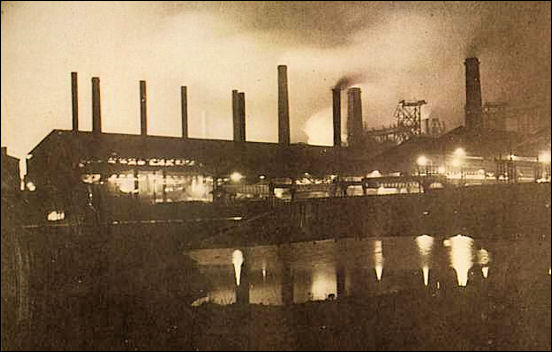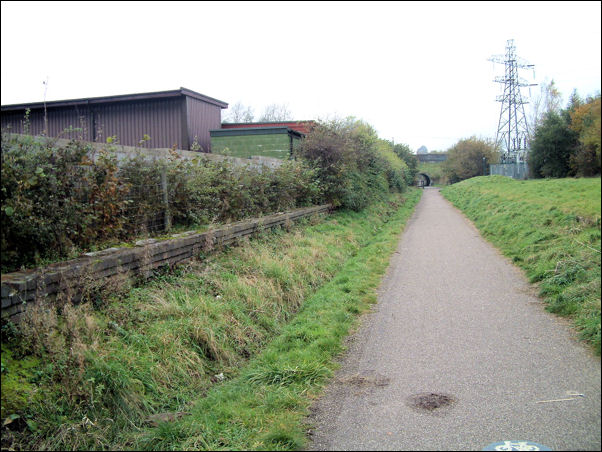“I wonder
whether it’s still possible to travel along the Potteries Loop Line,” I
say to historian Steve Birks. “Well not by train it isn’t,” he responds.
“And certainly not by steam train; Doctor Beeching put a stop to that in
1964. However I think we could do it except for the bridges and tunnels
that have been knocked down and blocked up. It’s worth a go just to see
how much the Potteries have changed.”
|
I
still remember the last time I travelled on the Loop Line. Returning
from Derby in 1960 I ended the first part of my journey at Etruria where I
caught the connection to Burslem. Leaving Etruria the train turned sharp
right and began a convoluted climb up to Hanley Station through Shelton
Bar and past Wedgwood’s works. It certainly wasn’t a journey for views for
all I could see were railway goods sidings, tall gasholders, ironworks,
dozens of potbanks and high chimneys of engineering plant. The train
steamed under a bridge at Etruria Road hissing with great effort between
rows of filthy goods sheds and mountains of steel rods.

The
Shelton works at night c.1924
It
passed under Etruria Road for the third time before pulling into the
curved platform of Hanley station terminating a journey of about ten
minutes. Despite the locked-in grime the down platform was quite
attractive standing on a slope beneath tiered offices and a parcel’s
depot. Above this was the noble edifice of the Grand Hotel where
businessmen lodged for the night and swanky women took afternoon tea.
If I
thought the landscape had been bad to Hanley worse was to come as the
train passed spoil heaps and mountains of cinders under Black Horse Lane
swinging on a serpentine transmission past coal wharfs, oil refineries
and marl holes so close I worried the carriage might fall into them. Then
the train crossed Waterloo Road into a tunnel before emerging into
Cobridge Station.
The views
were slightly better passing by Cobridge Park before suddenly plunging
back into the smoke and dust of Sneyd Colliery and Brickworks. Two more
bridges through a steep cutting brought the train to a stop at Burslem
Station in Moorland Road, a rough journey of roughly two miles covered in
a rough 20 minutes. |
“Industry
was the spirit of the Loop Line,” Steve comments. “And it was a quick way
to get from one end of the city to the other. And just think; your journey
from Derby to Burslem was achieved without any stops for traffic or
dawdling bus routes through town centres. All you had to do was keep your
eyes shut to avoid the grim views and prevent flying grit from getting
into them.”
The Loop
Line was certainly an benefit to travel, over the years providing a
service to millions of passengers embarking on shopping excursions, not
just to Hanley but to Manchester and Birmingham. It was a boon for
business; a conduit for commuters and for kids going to school.
“For a
hundred years it was a backbone of Potteries travel,” Steve continues.
“What’s more you could actually begin a journey at Burslem to the Orient
by train; amazing!”
Continuing north from Burslem the Loop Line followed Scotia Road over
a viaduct into a seemingly impossible sharp 1 in 90 climb to Tunstall
Station; then through the steep Victoria Park cutting to Pittshill Station
and uphill again to Newchapel and Goldenhill. This was the best part,
travelling beneath clear skies across the fileds of Turnhurst and
Newchapel. After this the line swept west into a steep descent for a mile
through more high embankments shielding the sight of the ugly Birchenwood
Gas and Coke works. A short, but imposing tunnel took the trains into
Kidgsrove Halt, the last Loop Line station behind Market Street after an
astonishing rollercoaster switchback ride through some 10 miles of the
worst scenery in the world.
“There’s no doubt that the Loop Line was difficult for the drivers
because of the frequency of sharp gradients and extreme curvature,” says
Steve. “But it was a terrific and popular route that connected the
people of North Staffordshire who otherwise would probably have remained
isolated. And of course it brought Kidsgrove people to Hanley when they
may have gone elsewhere for shopping, working and entertainment.”
It’s
true you never miss something until you want to use it again. And that
happened a generation after the Loop Line closed. The advance of tramcars
then buses, and the motor car ultimately did for Britain’s urban railways
in the 1960’s. Many people wish the line had never closed, but there
wasn’t a lot of resistance back when Beeching’s axe fell. Happily these
days the path of the Loop Line is still accessible for much of it has been
made into urban walkways.

![]()
![]()
![]()